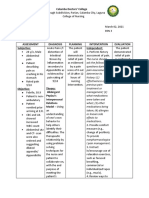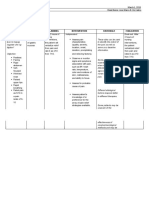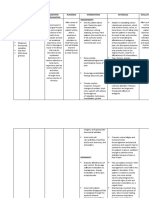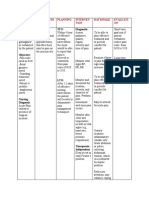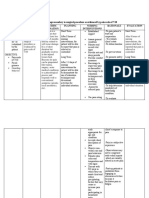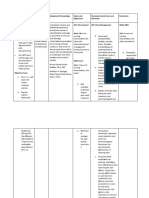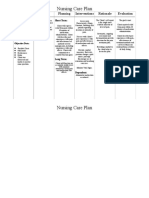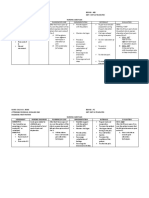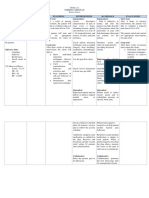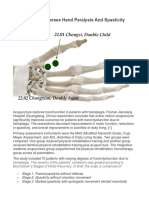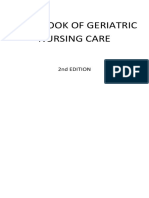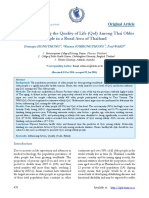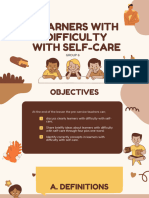0 ratings0% found this document useful (0 votes)
59 viewsNCP
NCP
Uploaded by
Krishna Faith P. Delara1) The patient rated their back pain a 5/10 and was grimacing.
2) Nursing goals were to reduce the pain rating to 3/10, teach relaxation techniques, and identify pain relievers.
3) The patient also reported fatigue, slowed movement, and drowsiness. Nursing goals were to improve energy, increase tolerable activities, and rate fatigue 3/10.
Copyright:
© All Rights Reserved
Available Formats
Download as DOCX, PDF, TXT or read online from Scribd
NCP
NCP
Uploaded by
Krishna Faith P. Delara0 ratings0% found this document useful (0 votes)
59 views6 pages1) The patient rated their back pain a 5/10 and was grimacing.
2) Nursing goals were to reduce the pain rating to 3/10, teach relaxation techniques, and identify pain relievers.
3) The patient also reported fatigue, slowed movement, and drowsiness. Nursing goals were to improve energy, increase tolerable activities, and rate fatigue 3/10.
Copyright
© © All Rights Reserved
Available Formats
DOCX, PDF, TXT or read online from Scribd
Share this document
Did you find this document useful?
Is this content inappropriate?
1) The patient rated their back pain a 5/10 and was grimacing.
2) Nursing goals were to reduce the pain rating to 3/10, teach relaxation techniques, and identify pain relievers.
3) The patient also reported fatigue, slowed movement, and drowsiness. Nursing goals were to improve energy, increase tolerable activities, and rate fatigue 3/10.
Copyright:
© All Rights Reserved
Available Formats
Download as DOCX, PDF, TXT or read online from Scribd
Download as docx, pdf, or txt
0 ratings0% found this document useful (0 votes)
59 views6 pagesNCP
NCP
Uploaded by
Krishna Faith P. Delara1) The patient rated their back pain a 5/10 and was grimacing.
2) Nursing goals were to reduce the pain rating to 3/10, teach relaxation techniques, and identify pain relievers.
3) The patient also reported fatigue, slowed movement, and drowsiness. Nursing goals were to improve energy, increase tolerable activities, and rate fatigue 3/10.
Copyright:
© All Rights Reserved
Available Formats
Download as DOCX, PDF, TXT or read online from Scribd
Download as docx, pdf, or txt
You are on page 1of 6
Nursing Priority #1
Assessment Nursing Diagnosis Planning/Objectives Interventions Rationale Evaluation
Subjective: Acute pain at the back After 8 hours of nursing Independent Independent: At the end of 8 hours of care, the
Patient rated as evidenced by care, the patient will be patient is able to:
pain 5/10 complaints of pain with able to: a. Obtain client’s/significant a. To fully understand
“Agay! Imong pain scale of 5/10, other’s (SO) assessment of client’s pain symptoms. Rate pain 3/10
kamot kay sakit facial grimace General: pain to include location, Verbalize less frequency
sa likod” Report pain is characteristics, onset, and severity of back pain
SO also controlled duration, frequency, Demonstrate use of
reported that quality, and intensity. relaxation skills like deep
patient has Specific: Identify precipitating or breathing when pain
been Rate pain 3/10 aggravating and relieving occurs.
complaining of Demonstrate factors Verbalized effectiveness of
back pain use of deep breathing exercises in
relaxation skills b. Perform pain assessment b. To demonstrate alleviating pain.
Objective: and diversional each time pain occurs. improvement in status
Seen with facial activities such Document and investigate or to identify worsening
grimace as, deep changes from previous of underlying condition/
Shows guarding breathing reports and evaluate developing
behavior exercises. results of pain complications.
Verbalize interventions
methods that
alleviated the c. Provide or promote c. To temporarily alleviate
pain such as nonpharmacological pain pain
praying, management:
meditation, etc.
d. Identify ways to avoid or d. To reduce occurrence of
minimize pain. muscle tension
e. Encourage adequate rest e. to prevent fatigue that
periods. can impair ability to
manage or cope with
pain.
Dependent:
a. Note client’s attitude a. Client may have beliefs
toward pain and use of restricting use of
pain medications, including medications, may have
any history of substance a high tolerance for
abuse drugs because of recent
or current use, or may
not be able to take pain
medications at all if
participating in a
substance abuse
recovery program.
Nursing Priority #2
Assessment Nursing Diagnosis Planning/Objectives Interventions Rationale Evaluation
Subjective: Fatigue r/t anemia After 8 hours of nursing Independent: At the end of 8 hours of care, the
Patient secondary to Chronic care, the patient will be a. Note daily energy a. This is helpful in patient is able to:
verbalizes Kidney Failure as able to: patterns determining
“kapoy akong evidenced by pattern/timing of Reported improved sense
lawas” verbalizations of General: activity. of energy
“Sige rana siyag tiredness, insufficient Report improved Perform activities tolerable
katulog.” As energy and altered sense of energy b. Encourage the client to b. To increase level of to him like eating on his
verbalized by concentration Perform tolerable do whatever possible tolerated activity own with minimal
his daughter activities assistance
Objective: Specific: c. Avoid or limit exposure c. Temperature and Verbalized “maayo na
Patient shows Verbalize reduction to temperature and humidity can greatly akong paminaw,” and
facial grimace of fatigue as humidity extremes impact energy levels “makabuhat nako og mga
when exerting evidenced by hilimuon sa akong makaya”
strength reports of d. Instruct d. To lessen patient’s Verbalized “mas ni abtik na
Drowsiness increased energy client/caregivers in fatigue akong mga lihok dae.”
Slowed and ability to alternate ways of doing Rated fatigue 3/10
movement perform tolerable familiar activities and
activities methods to conserve
ADLs Verbalizes energy
Bathing = 4 improved or
Dressing = 4 increased reaction
Grooming = 4 time and e. Encourage engagement e. Participating in
Mouth care = 4 movement in diversional activities, pleasurable activities
Toileting = 4 Rate fatigue 3/10 avoiding both can refocus energy and
Transferring bed/chair = with ten as the overstimulation and diminish feelings of
4 highest feeling of under-stimulation sluggishness, and
Walking = 4 fatigue unhappiness that can
Climbing stairs = 4 accompany fatigue
Eating = 4 Dependent:
a. Review medication a. Many medications have
regimen/other drug the potential side effect
use. of causing
/exacerbating fatigue
Nursing Priority #3
Assessment Nursing Diagnosis Planning/Objectives Interventions Rationale Evaluation
Subjective: Self-care deficit r/t After 8 hours of nursing Independent: At the end of 8 hours of care, the
Verbalized, weakness as evidenced care, the patient will be a. Assess cognitive a. To determine client’s patient is able to:
“kapoy akong by dependence in able to: functioning (e.g., ability to participate in
lawas dae og performing ADLs and memory, intelligence, care and potential to Verbalize “presko na akong
maglisod ko og verbalizations of General: concentration, ability to return to normal paminaw,”
lihok” weakness. Perform self-care attend to task) functioning or to Perform self-care with
activities within learn/relearn tasks. assistance
Objective: level of own Implement use of bigger
Patient is ability clothes for easy dressing
dependent/need Demonstrate
s assistance in techniques and b. Determine individual b. To incorporate into plan
performing lifestyle changes strengths and skills of of care enhancing
personal hygiene, to meet self-care the client likelihood of achieving
ADLs, and needs outcomes as well as to
bedside care Specific: determine the level of
activities Determines patient’s own ability
ADLs activities that are
Bathing = 4 tolerable to him
Dressing = 4 like eating
Grooming = 4 Asks for c. To guide and help
Mouth care = 4 assistance from c. Perform or assist with patient in performing
Toileting = 4 nurse in meeting client’s needs needs
Transferring bed/chair = performing
4 personal hygiene,
Walking = 4 and ADLs. d. Provide privacy and d. To reduce anxiety and
Climbing stairs = 4 Implementing equipment within easy for easy access of things
Eating = 2 use of bigger reach during personal needed during activities
clothes for easy care activities.
dressing
e. Allow sufficient time for e. To encourage in
client to accomplish performing activities
tasks to fullest extent of
ability. Avoid
unnecessary
conversation or
interruptions.
f. Instruct client to request f. To assist patient in
assistance when performing
needed, or stay with tasks/activities
client as dictated by
safety needs.
Dependent:
a. Review medication a. For possible effects on
regimen alertness/mentation,
energy level, balance
and, perception.
b. Assist with medication b. To guide patient with
regimen as necessary, intake of medications
encouraging timely use and to promote timely
of medications intake of medicine
You might also like
- Asher's OT Assessment ToolsDocument26 pagesAsher's OT Assessment Tools2p7tzrw9s9No ratings yet
- NURSING CARE PLAN of Hodgkin's Lymphoma: Assessment Nursing Diagnosis Planning Nursing Interventions Rationale EvaluationDocument5 pagesNURSING CARE PLAN of Hodgkin's Lymphoma: Assessment Nursing Diagnosis Planning Nursing Interventions Rationale Evaluationjoyrena ochondraNo ratings yet
- Nursing Care Plan (Pharyngitis)Document2 pagesNursing Care Plan (Pharyngitis)Angelokeizer Gavino75% (4)
- "I Don't Have An Infection in My Gallbladder Which Is Good, But I Do Feel The Pain," As Verbalized by TheDocument2 pages"I Don't Have An Infection in My Gallbladder Which Is Good, But I Do Feel The Pain," As Verbalized by Theunnamed person100% (1)
- NCP Charm EditedDocument6 pagesNCP Charm EditedampogeNo ratings yet
- Di Ko To Sure Kung Tama Yung Rel To Disease ProcessDocument8 pagesDi Ko To Sure Kung Tama Yung Rel To Disease ProcessNyeam NyeamNo ratings yet
- NCP Acute PainDocument3 pagesNCP Acute PainGeorge FogNo ratings yet
- PainDocument2 pagesPainAshley TwinkleNo ratings yet
- Planning Assessment Diagnosis Implementation Rationale EvaluationDocument1 pagePlanning Assessment Diagnosis Implementation Rationale Evaluationagathajade23No ratings yet
- NCPDocument8 pagesNCPAriaNo ratings yet
- Actual NCPDocument10 pagesActual NCPRouie Björn ABrianNo ratings yet
- NCP-Acute PainDocument2 pagesNCP-Acute PainMatt Reyes Del CastilloNo ratings yet
- Nursing Care Plan - Cesarean SectionDocument1 pageNursing Care Plan - Cesarean SectionMarceline VueenNo ratings yet
- NCP Sir EzerDocument5 pagesNCP Sir EzerJamaeca AbesamisNo ratings yet
- NCP Post OpDocument4 pagesNCP Post OpNIKKI CARYL ZAFRANo ratings yet
- Assessment Diagnosis Planning Intervention Rationale EvaluationDocument2 pagesAssessment Diagnosis Planning Intervention Rationale EvaluationAira AlaroNo ratings yet
- Amabel U. Cortez (G4A) March 1, 2019 Mary Mediatrix Medical Center Head Nurse: Jose Marco B. de CastroDocument9 pagesAmabel U. Cortez (G4A) March 1, 2019 Mary Mediatrix Medical Center Head Nurse: Jose Marco B. de CastroBel CortezNo ratings yet
- NCP NephrolithiasisDocument3 pagesNCP NephrolithiasisMANUEL EMERSONNo ratings yet
- Acute Pain SCMCDocument2 pagesAcute Pain SCMCWik Wik PantuaNo ratings yet
- Assessment Nursing Diagnosis Scientific Explanation Planning Intervention Rationale Evaluation IndeoendentDocument3 pagesAssessment Nursing Diagnosis Scientific Explanation Planning Intervention Rationale Evaluation IndeoendentDiane Sarino CabonceNo ratings yet
- Hemorrhoids N C P BY BHERU LALDocument2 pagesHemorrhoids N C P BY BHERU LALBheru LalNo ratings yet
- "My Neck Feels Stiff and There's Pain Coming From It. Every Time I Move It, It Only Gets Worse." As Stated by TheDocument4 pages"My Neck Feels Stiff and There's Pain Coming From It. Every Time I Move It, It Only Gets Worse." As Stated by TheCassey CuregNo ratings yet
- Aiza NCPDocument6 pagesAiza NCPponponolmedoNo ratings yet
- Subjective: Sto: Diagnostic:: Assessme NT Explanatio Nofthe Problem Planning Interven Tion Rationale Evaluati ONDocument3 pagesSubjective: Sto: Diagnostic:: Assessme NT Explanatio Nofthe Problem Planning Interven Tion Rationale Evaluati ONRona PieNo ratings yet
- Rheumatoid Arthritis Nursing Care Plan PDFDocument3 pagesRheumatoid Arthritis Nursing Care Plan PDFIzhra MargateNo ratings yet
- Assessment Diagnosis Planning Interventions Evaluation Nsg. Action RationaleDocument2 pagesAssessment Diagnosis Planning Interventions Evaluation Nsg. Action RationaleRhea Mae Valles - ReyesNo ratings yet
- NCP Case Pres Post OpDocument2 pagesNCP Case Pres Post OpKuda Gene LorenNo ratings yet
- Nursing Care Plan: Clustered Cues Nursing Diagnosis Rationale Outcome Criteria Nursing Interventions Rationale EvaluationDocument2 pagesNursing Care Plan: Clustered Cues Nursing Diagnosis Rationale Outcome Criteria Nursing Interventions Rationale EvaluationCLEMENT, EUGENE CHADNo ratings yet
- Breast Mastectomy NCPDocument3 pagesBreast Mastectomy NCPAndrea Jane T GarciaNo ratings yet
- Backpain NCPDocument3 pagesBackpain NCPxxarrowloverzxxdes23No ratings yet
- Diagnostic Findings:: Short Term Goal Short Term GoalDocument3 pagesDiagnostic Findings:: Short Term Goal Short Term GoalGiselle EstoquiaNo ratings yet
- NCPDocument3 pagesNCPHarland EstebanNo ratings yet
- Acute Lymphocytic LeukemiaDocument2 pagesAcute Lymphocytic LeukemiaJustine ConuiNo ratings yet
- NCP FractureDocument7 pagesNCP FractureMacris BondocNo ratings yet
- Pleural EffusionDocument5 pagesPleural EffusionTerizla MobileNo ratings yet
- NCP 2BCDocument6 pagesNCP 2BCPMG BrightNo ratings yet
- Module #8 NCP (Bernales, JLE)Document4 pagesModule #8 NCP (Bernales, JLE)Jan Lianne BernalesNo ratings yet
- Acute Pain Due To Labor Process NCPDocument1 pageAcute Pain Due To Labor Process NCPRhod Vincent Jamolod TayongNo ratings yet
- Nursing Care Plan Mrs. Patao Ob Ward, GSGH Assessment SubjectiveDocument3 pagesNursing Care Plan Mrs. Patao Ob Ward, GSGH Assessment Subjectiveraizelc100% (2)
- Nursing Care Pla1Document7 pagesNursing Care Pla1Ej PogiNo ratings yet
- NCP Acute PainDocument2 pagesNCP Acute PainKhleanne CastilloNo ratings yet
- Typhoid Fever NCPDocument46 pagesTyphoid Fever NCPLyra Lustre RN67% (3)
- Flank Pain, Anxiety...Document7 pagesFlank Pain, Anxiety...reneighdNo ratings yet
- NCP Gestational HypertensionDocument2 pagesNCP Gestational Hypertensionshila_glangNo ratings yet
- NCP - PainDocument3 pagesNCP - PainMegan PagapongNo ratings yet
- Nursing Care PlanDocument2 pagesNursing Care PlanWinter SpringNo ratings yet
- Nursing Care Plan For Patient With PNEUMONIA (Geriatrics)Document4 pagesNursing Care Plan For Patient With PNEUMONIA (Geriatrics)CHRISTIE MONTANO50% (2)
- Post-Operative Nursing Care Plan # 1Document14 pagesPost-Operative Nursing Care Plan # 1Vince John SevillaNo ratings yet
- Nursing Care Plan: Assessment Planning Interventions Rationale EvaluationDocument2 pagesNursing Care Plan: Assessment Planning Interventions Rationale EvaluationVanessa Belmonte AzurinNo ratings yet
- Nursing Care Plan - Labor PainDocument1 pageNursing Care Plan - Labor PainMarceline Vueen100% (1)
- Care PlanDocument2 pagesCare PlanAnonymous 9QBCcNNo ratings yet
- NCP - GeriaDocument4 pagesNCP - GeriaMarielle J GarciaNo ratings yet
- Name: Oyardo Cherilyn BED NO.: 408 Attending Physician: DR - Baldovino Diet: Diet As Tolerated Diagnosis: Post-PartumDocument7 pagesName: Oyardo Cherilyn BED NO.: 408 Attending Physician: DR - Baldovino Diet: Diet As Tolerated Diagnosis: Post-PartumshinloNo ratings yet
- NCP FinalDocument7 pagesNCP FinalKhlerdenz VillezonNo ratings yet
- Manguiat, Ncma 111 RomeoDocument4 pagesManguiat, Ncma 111 RomeoCiara ManguiatNo ratings yet
- Nursing Care Plan: Western Mindanao State University College of NursingDocument11 pagesNursing Care Plan: Western Mindanao State University College of NursingPatricia VasquezNo ratings yet
- Nursing Care Plan - Acute Pain Assessment Diagnosis Scientific Rationale Planning Intervention Rationale EvaluationDocument3 pagesNursing Care Plan - Acute Pain Assessment Diagnosis Scientific Rationale Planning Intervention Rationale EvaluationNicole cuencosNo ratings yet
- NCP Pain 1Document6 pagesNCP Pain 1goodemonz15No ratings yet
- Brain Surgery Post Op NCPDocument6 pagesBrain Surgery Post Op NCPunnamed personNo ratings yet
- SURGERY 1 Patient Assessment SheetDocument1 pageSURGERY 1 Patient Assessment SheetKrishna Faith P. DelaraNo ratings yet
- SURGERY 1 Attendance SheetDocument1 pageSURGERY 1 Attendance SheetKrishna Faith P. DelaraNo ratings yet
- Drug Study CCUDocument5 pagesDrug Study CCUKrishna Faith P. DelaraNo ratings yet
- RBS - Random Blood Sugar PDFDocument4 pagesRBS - Random Blood Sugar PDFKrishna Faith P. DelaraNo ratings yet
- Visual Arts History of The PhilippinesDocument119 pagesVisual Arts History of The PhilippinesKrishna Faith P. DelaraNo ratings yet
- Lifestyle Modification FINALDocument6 pagesLifestyle Modification FINALKrishna Faith P. DelaraNo ratings yet
- NCP FatigueDocument2 pagesNCP FatigueKrishna Faith P. DelaraNo ratings yet
- Attachment B - 2016 SPI Questionnaire - FINALDocument128 pagesAttachment B - 2016 SPI Questionnaire - FINALKrishna Faith P. DelaraNo ratings yet
- NGT Insertion 2022Document41 pagesNGT Insertion 2022Krishna Faith P. DelaraNo ratings yet
- Perioperative NursingDocument108 pagesPerioperative NursingKrishna Faith P. DelaraNo ratings yet
- Gastrointestinal DrugsDocument2 pagesGastrointestinal DrugsKrishna Faith P. DelaraNo ratings yet
- UTS - Chapter 1, Lesson 1Document3 pagesUTS - Chapter 1, Lesson 1Krishna Faith P. DelaraNo ratings yet
- Chapter 32 Assessment of Hematologic SystemDocument13 pagesChapter 32 Assessment of Hematologic SystemKrishna Faith P. DelaraNo ratings yet
- Acupressure, Shiatsu, VentusaDocument6 pagesAcupressure, Shiatsu, VentusaKrishna Faith P. DelaraNo ratings yet
- UTS - Chapter 1, Lesson 4Document2 pagesUTS - Chapter 1, Lesson 4Krishna Faith P. DelaraNo ratings yet
- N203 LRDRModule RLEfinal 1Document28 pagesN203 LRDRModule RLEfinal 1Krishna Faith P. DelaraNo ratings yet
- UTS - Chapter 2, Lesson 1Document9 pagesUTS - Chapter 2, Lesson 1Krishna Faith P. DelaraNo ratings yet
- Physiologic Changes of The Postpartal PeriodDocument13 pagesPhysiologic Changes of The Postpartal PeriodKrishna Faith P. DelaraNo ratings yet
- Resource Unit On Nutritional Needs of A NewbornDocument16 pagesResource Unit On Nutritional Needs of A NewbornKrishna Faith P. DelaraNo ratings yet
- Introduction of Health AssessmentDocument2 pagesIntroduction of Health AssessmentKrishna Faith P. DelaraNo ratings yet
- Structures and Functions of The BreastDocument11 pagesStructures and Functions of The BreastKrishna Faith P. DelaraNo ratings yet
- Nursing Assistance L3Document117 pagesNursing Assistance L3MaxNo ratings yet
- Care Plan On Acute Transient Psychiatric Disorder 2Document4 pagesCare Plan On Acute Transient Psychiatric Disorder 2Divya ThomasNo ratings yet
- Tagum Doctors College, Inc.: Mahogany ST., Rabesubd., Tagum City E-MailDocument4 pagesTagum Doctors College, Inc.: Mahogany ST., Rabesubd., Tagum City E-MailRoel John Atamosa CasilacNo ratings yet
- Write Up Template For My Positive Role ModelDocument6 pagesWrite Up Template For My Positive Role ModelHamad RayhanNo ratings yet
- Liko Overhead Lifts Design Planning Guide PDFDocument28 pagesLiko Overhead Lifts Design Planning Guide PDFI SabrinaNo ratings yet
- Buku Log Credentialing 2022 - Jurupulih CarakerjaDocument28 pagesBuku Log Credentialing 2022 - Jurupulih Carakerjatanmeng96No ratings yet
- Carer Payment and - or Carer Allowance Medical Report (SA332a) For A Person - 16 Years or OverDocument8 pagesCarer Payment and - or Carer Allowance Medical Report (SA332a) For A Person - 16 Years or OverWallace DunnNo ratings yet
- Measuring The Caregiver Burden of Caring For Community-Residing People With Alzheimer 'S DiseaseDocument13 pagesMeasuring The Caregiver Burden of Caring For Community-Residing People With Alzheimer 'S DiseaseSiti lestarinurhamidahNo ratings yet
- Experimental Gerontology: SciencedirectDocument11 pagesExperimental Gerontology: SciencedirectFebria Rike ErlianaNo ratings yet
- Acupuncture Reverses Hand Paralysis and SpasticityDocument3 pagesAcupuncture Reverses Hand Paralysis and SpasticityElizabeth NeilNo ratings yet
- Instrumental Activities of Daily LivingDocument3 pagesInstrumental Activities of Daily LivingAndrzej KlimczukNo ratings yet
- Modified Rankin Scale How To PDFDocument15 pagesModified Rankin Scale How To PDFKNI Maret 2023No ratings yet
- Assessment Is Making Assumptions. When You See It, You Attach It ToDocument18 pagesAssessment Is Making Assumptions. When You See It, You Attach It ToDonn Patrick AlegreNo ratings yet
- Home Health Care Agency AssignmentDocument9 pagesHome Health Care Agency Assignment184448No ratings yet
- Handbook of Geriatric Nursing Care (PDFDrive) PDFDocument676 pagesHandbook of Geriatric Nursing Care (PDFDrive) PDFPotato BananaNo ratings yet
- Factors Influencing The Quality of Life (Qol) Among Thai Older People in A Rural Area of ThailandDocument7 pagesFactors Influencing The Quality of Life (Qol) Among Thai Older People in A Rural Area of ThailandNanaNo ratings yet
- NCM 101 - Health Assessment SyllabusDocument2 pagesNCM 101 - Health Assessment SyllabusRA100% (4)
- Introduction To Therapeutic Exercises: Dr. Aroosha AbrarDocument14 pagesIntroduction To Therapeutic Exercises: Dr. Aroosha AbrararooshaNo ratings yet
- Association Between Working Memory Impairment and ActivitiesDocument6 pagesAssociation Between Working Memory Impairment and ActivitiesDaniel OrregoNo ratings yet
- L7 Learners With Difficulty With Self Care G6 PDFDocument45 pagesL7 Learners With Difficulty With Self Care G6 PDFJefrelyn Eugenio Montibon100% (1)
- HG - TG.1969.09.03. Valoración de Actividades de La Vida DiariaDocument8 pagesHG - TG.1969.09.03. Valoración de Actividades de La Vida DiariaAlejandro GuzmánNo ratings yet
- Alzheimers DiseaseDocument2 pagesAlzheimers Diseasekarl de guzmanNo ratings yet
- LV & Geriatrics 1.1 - Low Vision DefinitionsDocument27 pagesLV & Geriatrics 1.1 - Low Vision DefinitionsJohn DeanNo ratings yet
- Occupational Therapy Assessments & Health Measures: Clinical Ergonomics Laboratory Room A376Document56 pagesOccupational Therapy Assessments & Health Measures: Clinical Ergonomics Laboratory Room A376Maria AiramNo ratings yet
- Comment CDPAP FINALDocument11 pagesComment CDPAP FINALSagittarian YmailNo ratings yet
- Enhancing The Quality of Life of People With Intellectual Disabilities - From Theory To PracticeDocument455 pagesEnhancing The Quality of Life of People With Intellectual Disabilities - From Theory To PracticeletstopfightingNo ratings yet
- 2023 ResumeDocument5 pages2023 Resumeapi-689820167No ratings yet
- Health Resume Sukh ChahalDocument3 pagesHealth Resume Sukh ChahalCass DeldaNo ratings yet













